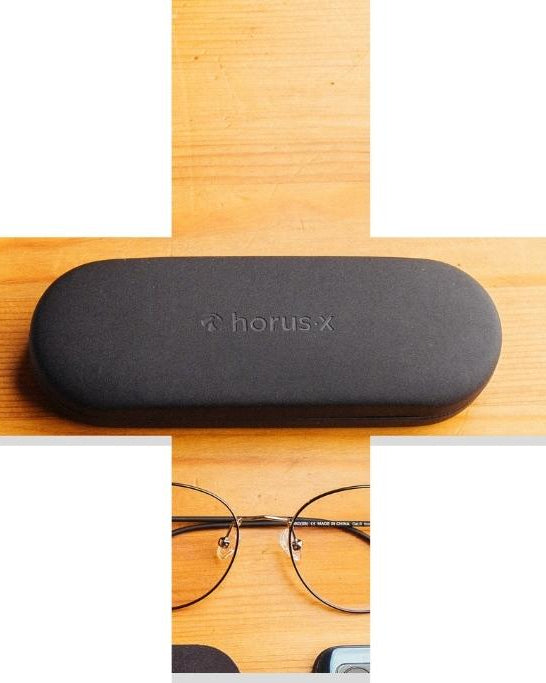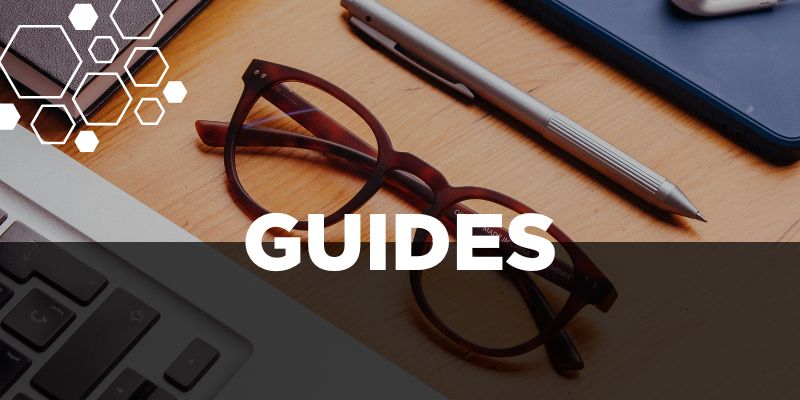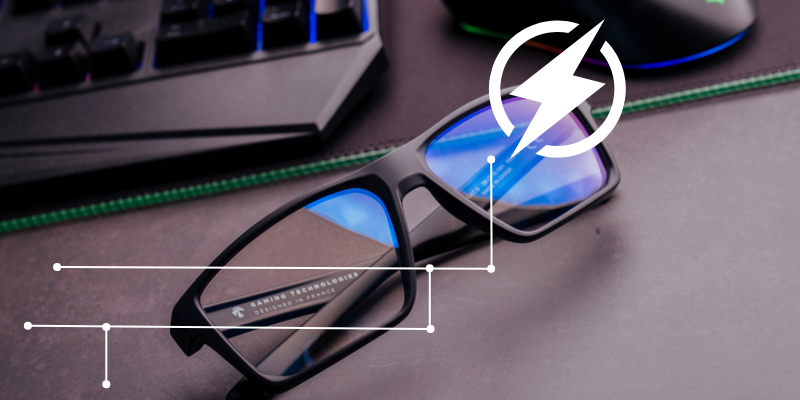Have you ever missed a step on the stairs after a long day on your computer? This isn't just due to your legendary clumsiness; it can also be linked to digital eye strain. Because yes, in addition to causing unpleasant symptoms, eye strain can disrupt your depth perception and your ability to accurately judge distances.
So, how does that happen, Jamy? Why can eye strain impair your 3D vision? And most importantly, how can we fix it? We'll explain it all in this article.
Depth perception or stereoscopic vision: how does it work?

Depth perception, also called stereoscopic vision (or even 3D vision, although there is a slight difference), is your brain's ability to judge distances and locate objects in space . It relies on binocular vision , the simultaneous use of both eyes, as well as the coordination of the eye muscles.
Basically, each eye will capture a slightly different image of the same situation. Then, the visual information will go to the brain, which will merge these two images to create an accurate and faithful representation of your environment.
It is this eye coordination that allows for 3D vision, the ability to see depth and judge distances between two objects . Particularly useful for reaching for an object on a shelf, driving without hitting the car in front of you, or avoiding a fall down a flight of stairs, this skill is extremely important.
Except! Even though it's an automatic process that your eyes and brain perform daily without apparent effort, it can be disrupted by several factors. And among them (dramatic music introduces the final boss): eye strain.
Reminder: eye strain

Before discovering how eye strain can impact stereoscopic vision, a brief reminder of what eye strain, or visual fatigue (or digital eye strain), is.
This refers to a set of symptoms that appear after intense and/or prolonged use of the eyes, and more specifically after prolonged exposure to artificial blue light . You know, that infamous light emitted by screens or LED lights that can be harmful if you're not exposed to it at the right time without protection!
Symptoms of eye strain:
- Headaches
- Blurred vision, difficulty focusing
- Dry, irritated, or even swollen eyes
- Excessive tearing
- Light sensitivity (or photophobia )
- Dizziness
- Difficulty concentrating
- Neck pain
If you want to know everything about the subject, we advise you to read our complete guide: digital eye strain, causes, symptoms and solutions .
How does visual fatigue affect depth perception?

Now that we've laid the groundwork, let's see how eye strain can worsen depth perception problems. As you might expect, when our eyes are tired, our vision is inevitably impaired.
Eye strain directly affects the coordination of eye muscles : while normally eye movements are coordinated to focus the eyes on the same point, this becomes more complicated. When the eyes are overworked (by screens, poor posture at the workstation, or a lack of breaks), these muscles tense up and struggle to synchronize .
As a result, the information reaching the brain does not allow for a clear image. Vision becomes blurred, it becomes difficult to judge distances, in short, 3D vision is severely impacted.
Eye strain and 3D vision: a vicious cycle

And that's not all! The more vision deteriorates, the more the eyes will tire trying to correct it. When depth perception becomes less precise, and convergence begins to tire, the brain and eyes instinctively try to compensate . The eye muscles therefore expend extra energy, which exhausts them even further.
This also applies in cases of strabismus, misalignment of vision, hyperopia, or any other refractive error. It's important to understand that these types of problems can also lead to eye strain, which can in turn negatively impact the quality of your vision . A vicious cycle, in short.
Our expert advice and solutions
We're stating the obvious, but it's true: prevention is better than cure. You don't want to end up struggling with your daily tasks, no, you want to preserve your visual comfort, and you're absolutely right. So here we're mainly giving you tips to avoid eye strain (and thus 3D vision problems), but also to help things if you've overexerted your poor eyes.
Adopt good daily eye hygiene

The best way to avoid eye strain is to take care of your eyes. No, they aren't designed to stay in front of a screen for hours without a break. Like all muscles, the eye muscles need a little exercise... and recovery.
Start by applying the 20-20-20 rule Every 20 minutes, look at an object 20 feet away from you (6 meters for non-English speakers) for 20 seconds. This will help to relieve eye strain and recalibrate your vision.
Next, make sure you take regular breaks: it's good for your eyes, but also for your posture at the office and your mental health! Every 45 to 50 minutes, get up, go for a short walk, disconnect from screens, and get some fresh air and natural light for at least 5 minutes. Your body and mind will thank you, and you'll be all the more productive at work .
Finally, to give your eyes a good rest , we recommend you adopt a habit that is extremely popular with the Horus X team: a nap !
Optimize your visual comfort

Don't neglect your visual environment: lighting, screens, blue light, everything is important to avoid short- and long-term damage.
Too much light, a screen that's too close, or air that's too dry can quickly turn a simple work session into a marathon for your eyes.
Pay particular attention to your workspace:
- ↔ Eye-screen distance : keep your screen at a distance of about 50 to 70 cm from your eyes and raise it if necessary.
- 🔦 Avoid direct light sources behind or in front of your screen: they cause reflections and glare .
- 🛋️ The color of your lighting: favor a warm and diffused light rather than an aggressive cold white.
- 🖥️ Adjust the brightness of your screen to that of your workspace: if your screen shines brighter than a neon light, your eyes will inevitably protest.
Invest in good blue light blocking glasses

You saw us coming a mile away, admit it! We keep going on about artificial blue light and the need to filter it properly.
But be warned, not all blue light blocking glasses are created equal! Opt for glasses that combine style and effectiveness, without breaking the bank (get the joke?). In other words, look for carefully designed models, patented technology that's simply the best on the market, a lifetime guarantee, and a fair price.
The suspense is over: these are obviously our blue light blocking glasses , designed to prevent eye strain with style and comfort. There are even Horus X blue light blocking glasses with prescription lenses (those with poor eyesight will no longer have any excuse).
Boost your eye coordination

As we mentioned earlier, your eye muscles need training and strengthening. So here, there's no need to tell them to do planks; their core exercises are simple binocular vision exercises , easy to do every day!
For example :
- Follow an object with your eyes : move a pen or your finger slowly in front of your eyes, from left to right and then from top to bottom, keeping your eyes fixed.
- Focus on a distant point : look at an object several meters away from you for a few seconds, then at something close, and alternate.
- Convergence exercise : slowly bring a pen closer to your nose while keeping both eyes aligned on the object (yes, it will make you cross-eyed, avoid doing it in public)
Simply do this little eye exercise 2 to 3 times a day for better eye coordination. Try it, and let us know how it goes!
When to consult a doctor?
First and foremost, only a healthcare professional can effectively diagnose and treat any disorder that may significantly impact the quality of your vision.
Next, if your eye muscles are too tired (or a little lazy, it happens to everyone), make an appointment for an orthoptic assessment. Regular checkups with an orthoptist will help improve your eye coordination and strengthen your eye muscles, ultimately improving your quality of life.
If you wear corrective glasses (or contact lenses ), you already know that regular checkups with your ophthalmologist are highly recommended. Your glasses lenses should always be properly fitted to your vision, so have them checked regularly . Similarly, after any surgery or if you have a neurological condition affecting your eyesight, don't neglect your eye health!
The final word: when eye strain disrupts stereoscopic vision
- Eye strain and depth perception are linked : when one falters, the other suffers. The reason is quite simple: if your eye muscles are tired, they lose coordination and your eyes can no longer focus properly. This results in blurred vision, difficulty judging distances, and all the other unpleasant symptoms of eye strain.
- And it's a vicious cycle! The more misaligned your vision is, the more your eye muscles will strain, become fatigued, and contribute to eye strain. Similarly, if you already have a vision problem, it can impact your 3D vision.
- To prevent all this, take care of your eyes daily : eye drops, regular breaks, blue light blocking glasses, visual coordination exercises, anything that can relieve tired eyes.
- If you reach the point where the problems are already present (because you didn't listen to our advice enough, we warned you), consult a specialist . A consultation with an ophthalmologist and an orthoptist can help improve (among other things) depth perception problems.
















